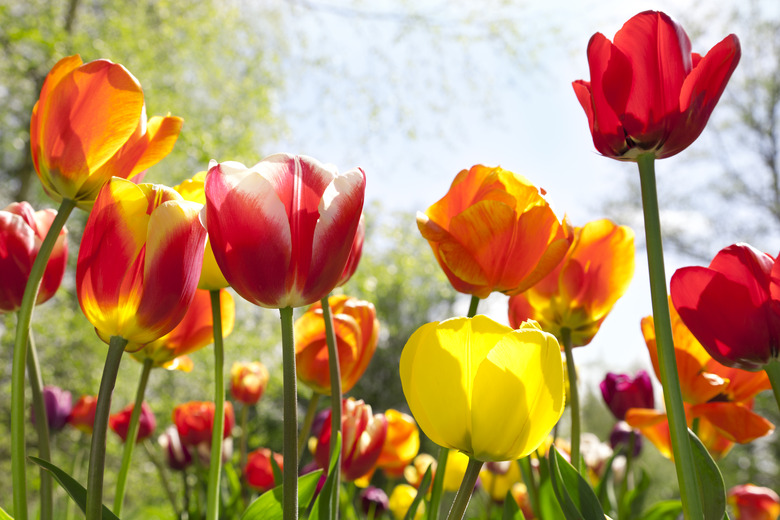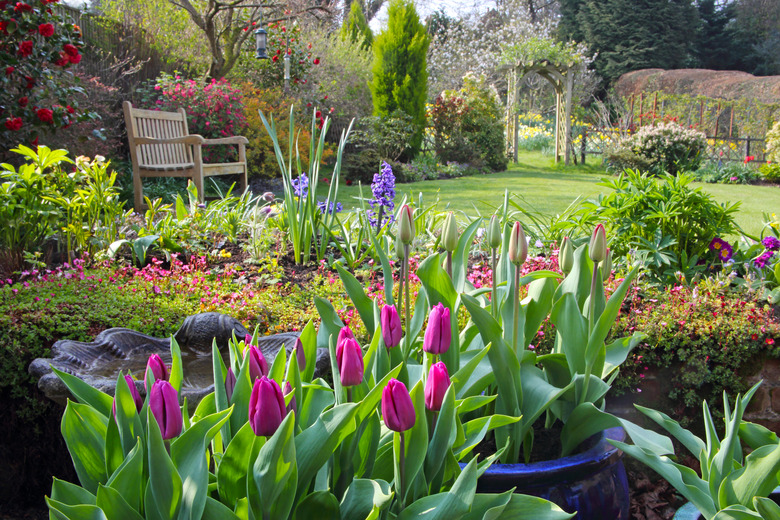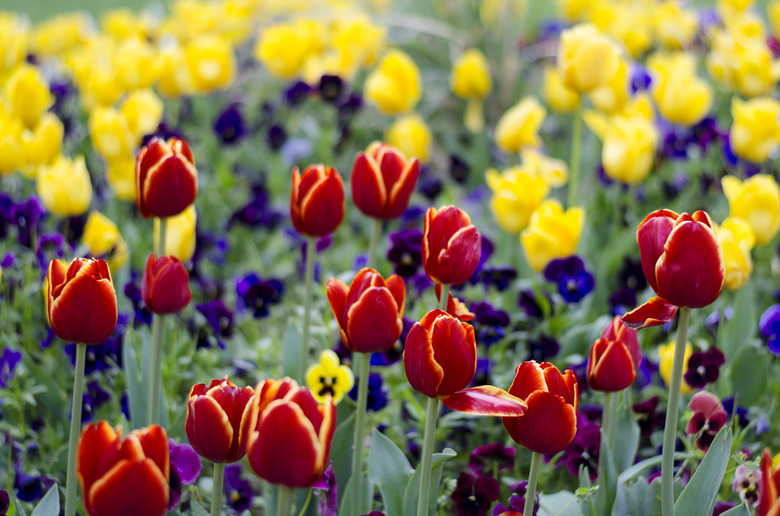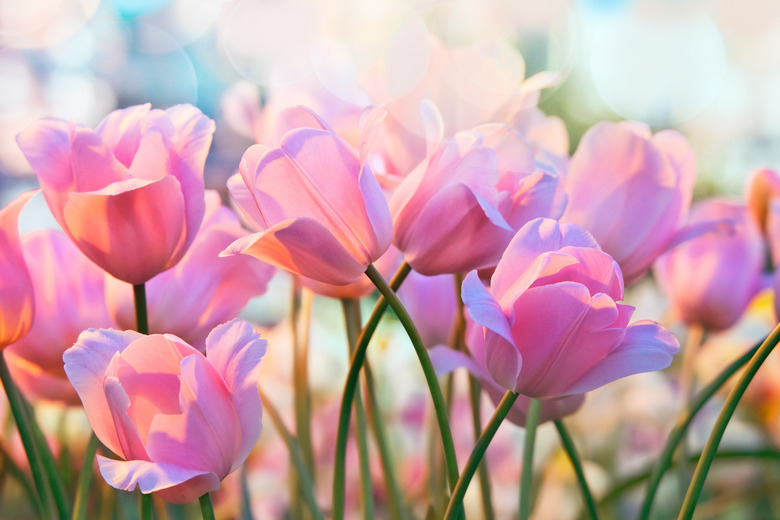How To Grow Tulips
We may receive a commission on purchases made from links.
Tulips (Tulipa spp.) are bulbous plants that flower in spring. Although tulips are classified botanically as perennials, gardeners often replant them each year, particularly those who live in warm climates. The flowers come in a variety of hues and can add a real pop of color to the backyard flower bed — or if you cut flowers from your garden to display in vases, tulips can add an early-season splash of warmth to any room.
Best Uses for Tulips
Best Uses for Tulips
Tulip plants are a delight in the garden, and they are planted purely for their beauty. The plants have upright flowers with one on each stem. The plant's flower generally is cup-shaped with three petals and three sepals, but a wild and wonderful variety of tulip species, hybrids and cultivars have been developed in a broad spectrum of colors and sizes.
Some tulips are small and look right at home when planted in a drift pattern in an informal woodland area, while others are large and impressive enough for formal English gardens. Some are as tall as 24 inches, while others top out at 6 inches. Some are single blossoms, and some are double. Many are shaped like simple cups, whereas others are goblet-shaped, ruffled, lily-shaped or fringed, and they can appear in other complex flower forms. Tulip flowers range in color from vibrant jewel tones to delicate and subtle pastels.
Plant tulips in garden beds, backyard borders or containers on the patio or deck. They look particularly impressive when planted closely in a bed or in a drifting cluster or grouping that sweeps across a lawn. It's a good idea to plant at least 10 bulbs of the same species or cultivar in an area for maximum visual impact. It is also possible to force tulip bulbs into blooming indoors. This allows you to have blooming bulbs inside when all the outdoor tulips have wilted and died.
How to Plant Tulip Bulbs
How to Plant Tulip Bulbs
- Select an appropriate planting area, taking exposure and soil into account.
- Dig up the planting site with a garden fork, working the soil to 12 to 15 inches.
- Then, mulch the area by adding several inches of organic compost on top and blend in well.
In general, you need to plant tulip bulbs some 6 to 8 inches deep. Another way to judge the depth is to plant each bulb three times as deep as the bulb is tall. The bigger the bulb, the deeper it should be planted. Set each bulb in a planting hole with the pointed tip pointing up, and then put soil in the hole and press it in lightly. Space the bulbs 4 to 6 inches apart. Smaller varieties can be planted closer together. Water the bulbs immediately after planting to encourage the roots to start growing. You want the root system to be developed before the first frost.
If you are going to try to use the bulbs for more than one year, add a little bulb fertilizer to the planting site to give them extra energy. If you are growing them as annuals, the bulbs themselves have sufficient nutrients to grow for one season.
In What Zone Do Tulips Grow Best?
In What Zone Do Tulips Grow Best?
Tulips are technically perennials and are hardy in U.S. Department of Agriculture plant hardiness zones 3 through 8. In their native range, the arid regions of Southern Europe and Central Asia, the plants grow back year after year from the original bulbs. However, given the years of hybridizing these plants and growing them in differing climates, this is not usually the case in North America. It is more likely that they won't grow back the second year.
For this reason, tulips are often grown as annuals in the United States. The bulbs are planted in autumn and develop a root system without sending up any foliage. They begin to grow in spring and develop buds that open and bloom. As the flowers fade, the gardener digs up the bulbs and discards them.
A few varieties, including botanical tulips, Darwin tulips and wild tulips, establish more easily than others and have a better chance of coming back the next year. These types of tulips may have the words "naturalizing" or "perennializing" on the packaging. A few cultivars that return reliably are Tulipa 'Little Beauty' (botanical tulip), a dwarf tulip with bright-purple flowers and a deep purple heart; Tulipa clusiana 'Cynthia' (botanical tulip), a bicolor tulip up to 10 inches tall; and Tulipa 'Ad Rem' (Darwin hybrid), with spectacular scarlet petals up to 24 inches tall.
When Should You Plant Tulips?
When Should You Plant Tulips?
Plant tulip bulbs in the fall when the nighttime temperatures drop to about 40 or 50 degrees Fahrenheit. The best time to plant is eight weeks before the date that the first hard frost is expected in your area. That gives the bulbs time to establish their root system before the cold arrives. Don't plant much before that time, though, since that leaves more time for disease to set in.
If your region does not get hard winter freezes, you can plant tulip bulbs in December or January. For example, in the South, experts recommend refrigerating the bulbs for 12 weeks and then planting at the end of the year. Generally, the bulbs require 12 weeks of chill in order to flower.
Soil, Sunlight, and Water Recommendations for Tulips
Soil, Sunlight, and Water Recommendations for Tulips
Tulips are native to arid regions of Asia, and they are not happy in overly moist soil. Plant them in well-draining, slightly acidic soil. Dry soil or sandy soil is preferable. The soil should be fertile but not moist.
Tulips require sunshine to grow, but they don't like heat. In most regions, a location that gets at least six hours of sun a day is ideal for growth. In warmer zones, dappled sunlight is probably a better choice. The flowers themselves last longer in the beds if they don't get hot sun in the afternoons.
Tulip bulbs need regular water once you plant them until the first frost. If it rains once a week, there is no need to irrigate during this period. If it doesn't, give them a drink. In the spring, the same rule applies. Normal spring rainfall amounts are usually sufficient to water these spring-flowering bulbs. If the spring happens to be particularly hot or dry, provide additional water to keep the flowers blooming. It's better to underwater than overwater these bulb plants, even with well-draining soil.
How to Propagate Tulips
How to Propagate Tulips
If you succeed at growing tulips as perennials, you may find that the bulbs eventually become overcrowded, like daffodils. In this case, the tulip bulbs must be divided and replanted. Once the tulip foliage dies back, carefully dig up the bulbs with a garden fork. You will see several or many smaller "daughter" bulbs growing around the big bulb. Many of these pull off easily. If not, separate them using a sterilized garden knife, but this is not usually necessary. Replant the daughter bulbs immediately or store them in the refrigerator and replant in the fall.
How to Winterize Tulips
How to Winterize Tulips
If you are growing tulips for one season only, you don't need to winterize them. Snowfall helps protect them from extreme cold. However, if you are hoping to get more than one flowering season, it helps to follow a few tips.
First, don't cut back the foliage as it yellows and wilts. Remove the flowers as they fade but allow the leaves to fade naturally. This gives the plant time to store energy for next year's bloom time. An extra dose of bulb fertilizer at this time can also be helpful in allowing the bulb to replenish itself.
If you live in a warm-winter region, you'll need to take those bulbs out of the ground to get them the appropriate chill time. Tulips need some 12 weeks of chilly weather. Dig the bulbs out after the flowers bloom and store them in the refrigerator until planting time.
Common Pests and Other Problems for Tulips
Common Pests and Other Problems for Tulips
Though tulips are a beautiful fixture in the spring garden, they aren't without their problems, which include failing to bloom, a variety of rodents, aphids, and slugs.
Failure to bloom the first year is perhaps the most common complaint of gardeners trying to grow tulips. It is very frustrating to carefully select and plant bulbs and then wait in vain for flowers. Although it is possible that the bulbs were not healthy, it is usually due to cultural care. Allowing the bulb to sit in wet soil is a prime reason for failure to bloom. Be sure your drainage is good and that you don't water too much.
Mice or moles looking for food sources in winter may dig up your tulip bulbs and eat them. You can prevent this by planting holly leaves or other sharp-edged leaves in the planting hole or use cat litter or crushed gravel.
Voles, squirrels, and other rodents may not be deterred by the leaves. Try enclosing the bulbs in wire mesh at planting time or covering containers with wire mesh. The mesh keeps out hungry critters while allow the tulip foliage and flower stalks to grow through it. It's the only surefire way to protect bulbs from hungry animals. It's important to note, however, that voles can get through the larger mesh of chicken wire, so you may need to use a smaller-meshed hardware cloth if voles are a problem in your garden.
Attacks from aphids are as common for tulips as they are for many other types of plants. These small bugs have mouthparts that allow them to pierce through leaves and then suck out the juices. One or two won't do much damage — in fact, you probably won't even notice them — but a large infestation can weaken the tulip and even kill it. Dislodge them with a stream of water from your garden hose.
Slugs are not particular about what leaves they eat. Almost any of your garden plants can be attacked. Look for holes in the leaves and torn edges. Set out shallow saucers of beer to make a deadly slug trap. Just as hungry and destructive as snails, garden slugs are easier to pick off. Go out to the garden on a moist morning and pick up as many as you can find.
Common Diseases for Tulips
Common Diseases for Tulips
The most common diseases for tulips are gray mold and bulb rot.
Gray mold is a disease caused by a fungus called Botrytis cinerea. It is an extremely common disease in garden beds, and weak or damaged plants are its primary victims. Look for water-soaked spots on the tulip leaves, starting out pale and turning gray as they mature. If the weather is very humid, you will see grayish fuzzy webbing on the leaves. To prevent this, water early in the day and don't water using overhead sprinklers. Dry leaves will not get gray mold.
Bulb rot is exactly what it sounds like: The tulip bulbs get soft and discolored. When you see these bulbs, you need to dig them up and dispose of them. The tulip plants suffering from bulb rot may not emerge in spring, or they may emerge with stunted, yellowed leaves. Prevent bulb rot by handling the bulbs carefully to avoid damaging them and making sure that the bulbs are planted in well-draining soil.



